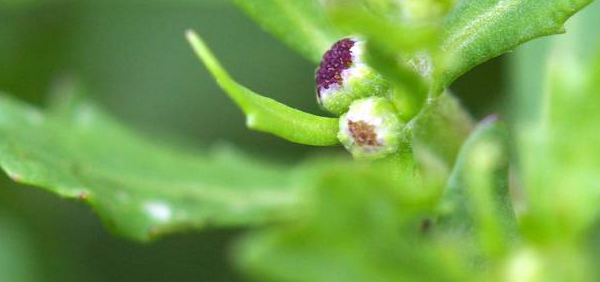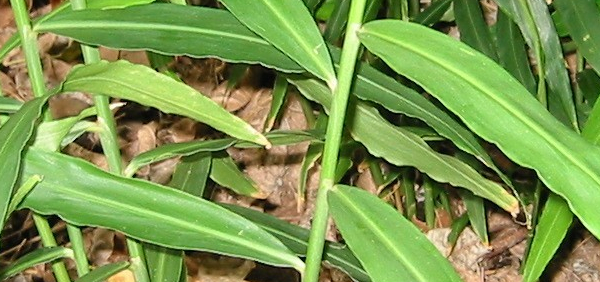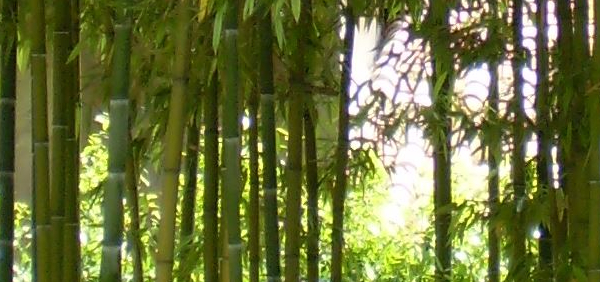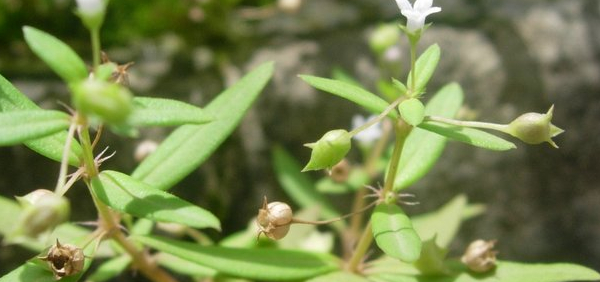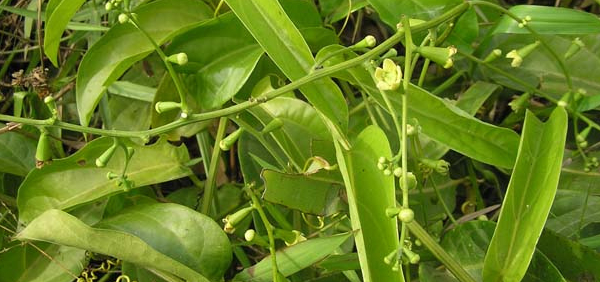khatmi :
 Khatmi consists of the root of Althma officinalis Linn. (Fam. Malvacem) a perennial, uniformly downy herb, occurring in Kashmir region.
Khatmi consists of the root of Althma officinalis Linn. (Fam. Malvacem) a perennial, uniformly downy herb, occurring in Kashmir region.HISTORICAL AND MYTHOLOGICAL REVIEW:
The whole plant, particularly the root, abounds with a mild mucilage, which is emollient to a much greater degree than the common Mallow. The generic name, Althaea, is derived from the Greek, altho (to cure), from its healing properties. The name of the order, Malvaceae, is derived from the Greek, malake (soft), from the special qualities of the Mallows in softening and healing. Most of the Mallows have been used as food, and are mentioned by early classic writers in this connexion. Mallow was an esculent vegetable among the Romans, a dish of Marsh Mallow was one of their delicacies. The Chinese use some sort of Mallow in their food, and Prosper Alpinus stated (in 1592) that a plant of the Mallow kind was eaten by the Egyptians. Many of the poorer inhabitants of Syria, especially the Fellahs, Greeks and Armenians, subsist for weeks on herbs, of which Marsh Mallow is one of the most common. When boiled first and fried with onions and butter, the roots are said to form a palatable dish, and in times of scarcity consequent upon the failure of the crops, this plant, which fortunately grows there in great abundance, is much collected for food. In Job XXX. 4 we read of Mallow being eaten in time of famine, but it is doubtful whether this was really a true mallow. Canon Tristram thinks it was some saline plant; perhaps the Orache, or Sea-Purslane. Horace and Martial mention the laxative properties of the Marsh Mallow leaves and root, and Virgil tells us of the fondness of goats for the foliage of the Mallow. Dioscorides extols it as a remedy, and in ancient days it was not only valued as a medicine, but was used, especially the Musk Mallow, to decorate the graves of friends. Pliny said: Whosoever shall take a spoonful of the Mallows shall that day be free from all diseases that may come to him. All Mallows contain abundant mucilage, and the Arab physicians in early times used the leaves as a poultice to suppress inflammation. |
Taxonomical Classification
Kingdom: Plantae - Plants
Subkingdom: Streptophyta
Superdivision: Spermatophyta - Seed plants
Division: Magnoliophyta - Flowering plants
Class: Magnoliopsida - Dicotyledons
Family: Malvaceae
Genus: Althaea
Species: Althaea officinalis
Allied species:
-VERNACULAR NAMES
Sanskrit: Khatmi,Picchilamula,supuspaEnglish: marshmallow
Hindi: Khatmi,Gulkhairo
Urdu: Aslua Khitmi, Reshah-e-Khatmi
Telugu: Khatmi
Bengali: -মার্শ mallow Mārśa mallow
Marathi: Khatmi
Gujarathi: -માર્શ મોલો Mārśa mōlō
Tamil: Khatmi
Malayalam: -മാർഷ് മല്ലോ mārṣ mallēā
Kannada: - ಮಾರ್ಷ್ಮ್ಯಾಲೋ
Punjabi: - ਮਾਰਸ਼ ਮਾਸਕੋ Māraśa māsakō
Sindhi: - مارشل ميڪو
Arabic: Baer-ul-Khtmk
Spanish: - marsh mallow
Japanese: -マーシュマロー Māshumarō
Chinese: -沼泽锦葵 Zhǎozé jǐn kuí
French: -guimauve
German: Adewarzeal,Eibisch
Burma: -narrmhar mallow
Nepal: -मार्शल मल्ल Mārśala malla
Persian: Gulkhairo
Sinhalese: -මාෂ් māṣ
Greek: -μολόχα molócha
Varities:
-There are two distinct types of marshmallows, Levin explained: confectionery and pâte de guimauve. Confectionery marshmallows tend to be the mass-produced type, and include both Krafts Jet-Puffed Mallows and Lucky Charms petite marshmallows.Synonyms
Synonyms in Ayurveda: khatmi-Mallow, Marsh
Rasa: Madhura
Guna: Guru Picchila Snigdha
Veerya: Sheetha
Vipaka: Maduram
Karma: Kaphahara Mootrala Pittahara Vatahara Vedanasthapaka
Marshmallow was traditionally used as relief for irritation of mucous membranes, including use as a gargle for mouth and throat ulcers and gastric ulcers. In Russia, the root syrup is sold without a prescription by pharmacies, with intent to treat minor respiratory ailments.
Cultivation:
Plants are hardy to about -25°cSucceeds in almost any soil and situation, though it prefers a rich moist soil in a sunny position. It also tolerates fairly dry soil conditions
Propogation:
Seed - sow spring or autumn in a cold frame. The seed is best sown as soon as it is ripe in late summer, the germination is often erratic. Stratification can improve germination rates and time. Prick out the seedlings into individual pots when they are large enough to handle and plant them out in the summer[].Division in spring or autumn. Fairly easy, it is best to pot up the divisions in a lightly shaded position in a cold frame or greenhouse until they are growing away well and then plant them out into their permanent positions.
Root cuttings in early winter.
Harvesting:
The root is best harvested in the autumn, preferably from 2 year old plants, and is dried for later use. Nonlignified roots of the second years growth, which are washed and cut into cubes or powdered, are used for pharmaceutical purposesPhytochemistry:
Galacturonic acid, galactose, glucose, xylose & rhamnose,polysaccharide althma mucilage-O, asparaginene, betaine, lecithin and phytosterol, polysaccharidesPHARMACOLOGY:
IMPORTANT FORMULATIONS – Gojihvadi Kvatha CurnaParts used for medicinal purpose
Root, Seed, ,Dosage:
3 -6 gSubstitute:
Roots of Centaurea behen Linn.)Adultrants:
It can be adultrated with the root of hollylock, Althaea rosea. The root of Althaea officinalis are also found to be adulterated with roots of Lavatera thuringiaca Linn. The unpeeled roots of Althaea officinalis are sometimes used to adulterate belladonnaControversy:
The efficacy of the flavonoids contribution to hypolipidemia is controversialCommercial value:
-There is a marshmallow plant, and marshmallows used to be made from the extract of its roots, but today it is made of corn syrup, gelatin, gum arabic, egg and flavorings. The gelatin is softened in water and gum Arabic and flavorings are added. They look like little fluffy pillows of sugar. Marshmallow creme is a thick, whipped mixture of the stuff sold in jars. Commercial marshmallows where introduced in the 19th century. Marshmallow cream is also available in jars and is simply whipped marshmallow. Marshmallows are loved by adults and children. Marshmallows come in two sizes large and mini. They can be eaten as is, placed on top of hot chocolate, used to make desserts if many kinds.Morphology:
Roots 0.2 to 3 cm in diameter, light brown in colour, strongly longitudinally furrowed, often spirally twisted; fracture, short, texture rough, internally yellowish white; odour, pleasant; taste, sweet and mucilaginous.Histology:
T.S. root circular in outline; cork 8 to 12 cells broad, radially arranged flattened cells; cortex broad, loosely arranged, parenchymatous, cells filled with mucilage; small patches of lignified fibres present; large number of schizogenous and lysigenous mucilage canals present; phloem well developed consisting of sieve tubes, companion cells and phloem parenchyma filled with mucilage; cambium 2 to 3 celled, xylem diffuse porous, made up of vessels, tracheids, fibres, and tracheidal fibres, vessels mostly solitary – filled with tyloses at some places, medullary rays 3 to 5 cells deep; rosette crystals of calcium oxalate present in cortical, phloem and xylem region; cells contain mucilage, stained red with 1% ruthenium red, and deep yellow with potassium hydroxide solution; most of the parenchymatous cells contain starch grains, polygonal to rounded, 5 to 20 nm, most grains less than 12 nm in diameter, simple, hilum circular or a 2 to 5 rayed cleft lamellm indistinct.Geographical distribution:
This species is globally distributed in Northern Africa, Europe, Asia, Afghanistan and India, naturalised in United States.Within India, it has been recorded in the Himalayan region from Kashmir to Punjab.ECOLOGICAL ASPECT:
-A perennial herb of coastal habitats, growing on the banks of ditches containing brackish water, in brackish pastures, and in the transition zone between the upper saltmarsh and freshwater habitats. It is intolerant of grazing and cutting. It also occurs as a garden escape. Lowland.Plant conservation:
-Exact status definitions can vary from state to state.| Threat status Europe | Least Concern (IUCN) |
|---|
General Use:
Marshmallow is indicated for use in conditions of pain and inflammation in the digestive tract and the mouth, throat and respiratory system. Two separate parts of the plant have been used traditionally, the roots have been used for digestive problems and on the skin, whilst it is the leaves that are used to treat lungs and the urinary system. However it is this coating, soothing and healing property that Marshmallow is known for, and it is the mucillage in the Marshmallow plant that has this action.Therapeutic Uses:
Mutradaha, Daha, Kasa, Mutrakrcchra, Pratisyaya, Raktapitta, Mutrasayasotha, Kantharoga, AntrasothaSystemic Use:
- The root of the plant drug is suitable for uses as medicine.Roots are quite mucilaginous and roots need to be utilized after peeling off their outer bark.Root is pleasantly odourous,light and slightly sweet or sweetish in taste.Roots give ash on burning.
- Seeds and leaves are externally applied to inflammation,localized oedema or swelling,boil,painful organ.Decoction of infusion of seeds and flowers is given in cough and respiratory disease as it effects as demulcent medicine in respiratory tract.Seeds are also mucilaginous and given in diarrhea.Dysentery,urinary burning sensation and intestinal inflammation.Roots are mainly antiphlogistic and anti-cough and in corsya and dry cough,the decoction of roots,seeds and flowers is given.Trophical effect is also analgesic of drug beside other medicinal properties.
- It is an emollient and is used in making absorbent pills and pestilles.Leaves are useful in preparation of a soothing ointment.
- The roots are available in market as Resha Khatmi and used as a drug in medicine.Flowers commonly known as Tukhma Khatmi besides other parts like stem,leaves,gum are used for medicinal purpose.
- The flowers of Khatmi are useful in the form of infusion of bronchial catarrh,cough and bronchitis.Flowers are externally applied over burns;root,seed, leaves,stem, and gum are medicinally besides flowers.
- The flower of Althea officinalis are cooling and diuretic,they are useful in rheumatism,decoction is used as demulcent in affection of respiratory organ
Administration:
Taking marshmallow at the same time you take medications by mouth can decrease the effectiveness of your medication. To prevent this interaction take marshmallow at least one hour after medications you take by mouth.Pharmacological:
- Antrasotha-antravarodha
- Pravahika
- Pratisyaya-kasa
- Mutrakrchra-mutradaha
- Vranasodha-Phuphusasotha
- Kanthasotha
- Snehana
- Anulomana
- Slesmahara
- Sodhahara-Vedhanasthapana
- Mutranjanana
Clinical trials:
- Bucchi S,Vogelin R,Von Eiff MM,Ramos M,Melzer J,open trial to assess aspect of safety and efficacy of a combined herbal cough syrup with ivy and thyme.Torsch komplementarmed klass,Naturheilkd 2005 Dec 10:328-32
- Blumenthal M,Goldberg A,Brinckmann J.Herbal medicine,explained commission E Monographs.Newton ,MA Intergrative 2000:244-248
Research:
- 1.Nosal Ova G,Strapkova A,Kardosova A,Capek P,Zathureck L,Bukovaka E(Antitissve action of extracts and polysaccharides of marshmallow L,var,robusta) Pharmazie 1992;47(3) 224-226
- 2.Scbulz V,Hansel R,Tyler V,Rational Phytotherapy;A,Physician guide to herbal Medicine,4th Berlin Germany Springer,2000:29,182
- 3.Sutovska M,Nosalova G,Tranova S,KArdosova A:The antirussive activity of polysaccharides from althea officinalis L,Var Robusta,Arcrium Lappa L…var Herkules And prumus persica L,Batsch Bratist Lek Listy 2007:108(2):93-9
4.Unani perspective of Khatmi (Althaea officinalis) Nazeem Fahamiya Mohamed Shiffa Mohd Aslam Farzana Muzn
Precautions:
Toxicity studies:
Use in other system of medicine:
Unani actions and usesCONCLUSION:
Khatmi (Althaea officinalis), commonly known as Marsh Mallow is one of the important medicinal plant used in Unani medicine. Khatmi is a perennial plant with light brown coloured, long and thick root, ovate-cordate, slightly toothed leaves and pale pink or pale purple coloured flowers. Root, leaves, flowers and seeds are mainly used in medicine. All the parts contain mucilage. It is having emmollient, analgesic, astringent, haemostatic, expectorant, luxative, cleansing, demulcent, concoctive, diuretic, emmenagogue, anti-inflammatory and exhilarant properties. In Unani medicine, Khatmi has been used for several centuries to treat inflammatory disorders like metritis, enteritis, mastitis, arthritis, colitis, bronchitis, gastritis, etc. It also has been used for other ailments like catarrh, renal calculai, pityriasis, tremor, dysuria, dysentery, haemoptysis, whooping cough and many more.KEY WORDS: khatmi Althea officinalis Linn.
- » Classification and names of khatmi
- » Synonyms and definitions of khatmi
- » Drug Properties of khatmi
- » Chemical Constituents of khatmi
- » Standardization of khatmi
- » Parts used and Dosage of khatmi
- » Morphology and Histology of khatmi
- » Distribution and Conservation of khatmi
- » Cultivation of khatmi
- » khatmi in the market
- » Medicinal Uses of khatmi
- » Researches and clinical trails of khatmi
- » khatmi in other sytems of medicine
- » Ayurvedic formulations with khatmi
- » Images of khatmi



